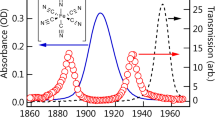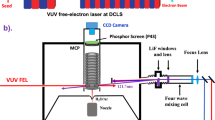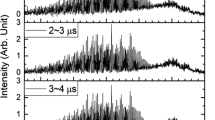Abstract
THERE have been a number of recent investigations on the production of Vibrationally excited species by the method of flash photolysis1–5 with particular reference to two possible mechanisms, direct vibrational excitation or the initial formation of an electronically excited state the energy of which is then reorganized internally. Basco and Norrish1 have concluded that vibrationally excited nitric oxide was produced directly on photolysing nitrosyl chloride, whereas Symons and Yarwood4,5 have interpreted their observation of the production of CCl radicals in the photolysis of a number of halogenated methanes in terms of the formation of an electronically excited substituted methyl radical the energy of which was internally converted into vibration. Experiments have been carried out on the flash photolysis of trichloronitrosomethane (CCl3NO) in an attempt to determine the fraction of energy appearing as vibration in each fragment produced on photolysis and to attempt to determine which of the two possible mechanisms is operative in this case. A new transient spectrum resulting from the photolysis of this molecule is also reported.
This is a preview of subscription content, access via your institution
Access options
Subscribe to this journal
Receive 51 print issues and online access
$199.00 per year
only $3.90 per issue
Buy this article
- Purchase on Springer Link
- Instant access to full article PDF
Prices may be subject to local taxes which are calculated during checkout
Similar content being viewed by others
References
Basco, N., and Norrish, R. G. W., Disc. Farad. Soc., 162 (1962).
Basco, N., Callear, A. B., and Norrish, R. G. W., Proc. Roy. Soc., A, 260, 459 (1960).
Callear, A. B., and Norrish, R. G. W., Nature, 188, 53 (1960).
Symons, J. P., and Yarwood, A. J., Trans. Farad. Soc., 57, 2167 (1961).
Symons, J. P., and Yarwood, A. J., Proc. Chem. Soc., 62 (1962).
Norrish, R. G. W., and Oldershaw, G. A., Proc. Roy. Soc., A, 249, 498 (1959).
Norrish, R. G. W., Porter, G., and Thrush, B. A., Proc. Roy. Soc., A, 216, 165 (1953).
Gordon, R. D., and King, G., Canad. J. Phys., 39, 352 (1961).
Hazeldine, R. N., and Jander, J., J. Chem. Soc., 696 (1954).
Herzberg, G., Spectra of Diatomic Molecules (Van Nostrand, New York, 1951).
Walsh, A. D., J. Chem. Soc., 2260 (1953).
Author information
Authors and Affiliations
Rights and permissions
About this article
Cite this article
HUSAIN, D. Production of Vibrationally Excited Species from the Photolysis of Nitroso Compounds. Nature 195, 796–797 (1962). https://doi.org/10.1038/195796a0
Issue Date:
DOI: https://doi.org/10.1038/195796a0
This article is cited by
-
Kinetics and mechanism in the decomposition of CCl4 in a radio-frequency pulse discharge
Plasma Chemistry and Plasma Processing (1985)
Comments
By submitting a comment you agree to abide by our Terms and Community Guidelines. If you find something abusive or that does not comply with our terms or guidelines please flag it as inappropriate.



